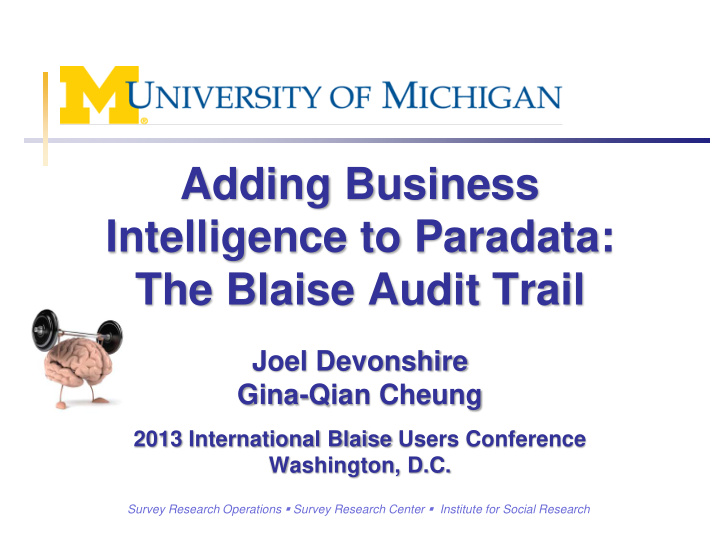



Adding Business Intelligence to Paradata: The Blaise Audit Trail Joel Devonshire Gina-Qian Cheung 2013 International Blaise Users Conference Washington, D.C. Survey Research Operations Survey Research Center Institute for Social Research
First, I have some questions….. • How does total interview length look across the sample and by key grouping variables? • What questions in my data model may be problematic? • Are there particular interviewers having problems or potentially falsifying data? • Are the data models rules working as expected? • Where do interviewers tend to suspend the instrument, enter remarks, or access help? • Did a new version of our data model have any discernible effects on iwer behavior or data entry? • How many days does it take to fully complete an iw? SRO SRC ISR 2 2013 International Blaise Users Conference, Wash D.C.
Now, a bit of background… • Simply putting audit trail data into a database doesn’t facilitate exploratory analysis • Queries are slow and data is “disconnected” • We needed to design a tool that made ADT data as accessible as possible • We chose the OLAP cube as a means of transforming the “raw” ADT data into something more meaningful Create a multidimensional space where data is pre- aggregated and joined with other data SRO SRC ISR 3 2013 International Blaise Users Conference, Wash D.C.
Creating a cube… ADT OLAP Data Warehouse Raw ADT ETL Analysis/ Other Data Sources Reporting SRO SRC ISR 4 2013 International Blaise Users Conference, Wash D.C.
5 2013 International Blaise Users Conference, Wash D.C.
DEMO 6 2013 International Blaise Users Conference, Wash D.C.
OLAP Cube Advantages • Extremely flexible and open; invites data exploration and new query ideas • Pulls together data from many sources • Very customizable, with ability to define limited views and data of interest • Accessible with familiar tools • Possible to use as basis of “dashboard” with key metrics and reports SRO SRC ISR 7 2013 International Blaise Users Conference, Wash D.C.
Challenges/Constraints • After initial design, changes are relatively easy, but still under centralized control • Can be deceptively “easy” to use Calculations and conclusions still need to be carefully thought through Building an OLAP cube can be “overkill” • Harmonization among studies SRO SRC ISR 8 2013 International Blaise Users Conference, Wash D.C.
Thank You! jdev@umich.edu qianyang@umich.edu 9 2013 International Blaise Users Conference, Wash D.C.
Recommend
More recommend